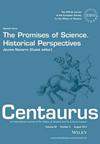古传染病学:研究过去传染病的生物考古学和生物社会学方法
IF 0.5
1区 哲学
Q3 HISTORY & PHILOSOPHY OF SCIENCE
引用次数: 4
摘要
从考古环境中提取的骨骼为评估一般疾病和流行病的时间,特别是在过去社会中,提供了大量数据。生物考古记录对麻风病、结核病、鼠疫(黑死病)和密螺旋体病等世界上一些最具灾难性疾病的发病时间提供了一个特别重要的视角。古基因组学和古遗传学的新发展为记录古代病原体的DNA(例如黑死病)、追踪它们的历史和评估它们的起点和终点提供了新的机会。疾病终末的古病理学记录是复杂的,部分原因是由于过去的社区经历了麻风病和鼠疫等重叠流行的情况。在大多数情况下,这些综合征(即两种或两种以上流行病之间存在相互作用)会加剧并加重社区或地区的发病率负担。了解流行病的严重程度和持续时间的基础是考虑同时影响社区或地区特定传染病的严重程度和持续时间的多种因素,包括口腔健康状况不佳、营养不良、缺铁性贫血和寄生虫负荷升高。我们认为,要理解流行病的开始、中期和结束,就需要了解更广泛的流行病背景,了解破坏健康和社区稳定的多种具有挑战性的情况,以及生物社会因素如何以不同的方式影响个人的免疫能力。这篇文章提供了几个应用生物考古学和综合症理论来理解流行病如何结束的例子。即使在看似结束之后,病原体仍在继续传播。实际上,没有什么“终结”,只有机会致病菌的进化和我们减轻它们的能力(或不能力)。本文章由计算机程序翻译,如有差异,请以英文原文为准。
Paleosyndemics: A Bioarchaeological and Biosocial Approach to Study Infectious Diseases in the Past
Skeletons drawn from archaeological contexts provide a fund of data for assessing disease in general and timing of epidemics in particular in past societies. The bioarchaeological record presents an especially important perspective on timing of some of the world's most catastrophic diseases, such as leprosy, tuberculosis, plague (Black Death), and treponematosis. Application of new developments in paleogenomics and paleogenetics presents new opportunities to document ancient pathogens' DNA (for example, Black Death), track their history, and assess their beginning and end points. Paleopathological documentation of disease terminus is complex, in part owing to circumstances where past communities experienced overlapping epidemics, such as leprosy and plague. For most settings, these syndemics-whereby there is an interaction between two or more epidemic diseases-both exacerbate and enhance the burden of morbidity in a community or region. Fundamental to understanding the severity and duration of epidemics is the consideration of multiple factors that simultaneously influence the severity and duration of the specific infectious diseases in a community or region, including poor oral health, under-nutrition, iron deficiency anemia, and elevated parasite load. In our view, comprehending the beginning, the middle, and the end of epidemics requires understanding the wider context of syndemics, the multiple challenging circumstances that undermine health and community stability, and how biosocial factors differentially affect the immune competence of individuals. This article provides several examples of the application of bioarchaeology and syndemics theory in achieving an understanding of how epidemics end. Pathogens continue to circulate, even after what appears to be the end. In effect, then, there is no "end," just evolution of opportunistic pathogens and our ability (or not) to mitigate them.
求助全文
通过发布文献求助,成功后即可免费获取论文全文。
去求助
来源期刊

Centaurus
HISTORY & PHILOSOPHY OF SCIENCE-
CiteScore
3.10
自引率
25.00%
发文量
52
审稿时长
>12 weeks
期刊介绍:
Centaurus publishes an international spectrum of original research papers, historiographical articles, and other academic content on the history of science in the broadest sense, including mathematics, medicine, biomedical sciences, earth sciences, social sciences, humanities and technology, and their social and cultural aspects. We also invite contributions that build a bridge between history of science and other disciplines. Book notices, book reviews and essay reviews of publications within the journal''s scope are commissioned to experts. The Editor encourages suggestions for special issues, short papers on topics of current interest and articles suited to open peer commentary along with a list of potential commentators.
 求助内容:
求助内容: 应助结果提醒方式:
应助结果提醒方式:


